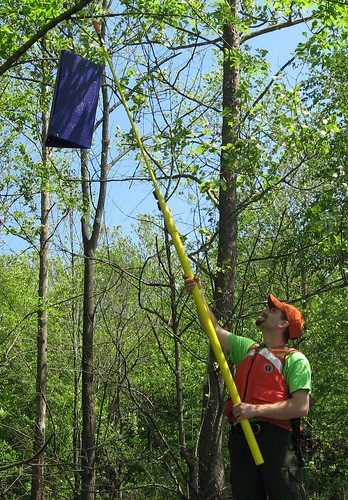
Animal Plant Health Inspection Services’ (APHIS) Brian Deschu sets EAB detection tools (purple traps) along the roadside right-of-way as part of the national effort to survey for this invasive, tree-killing pest.
Like others across the country, Deschu is selecting suitable ash trees─those with enough height and girth and branches strong enough to bear an 8-pound weight. With an ash limb as a target, Deschu maneuvers the Barney trap (nicknamed for a certain purple-hued TV dinosaur) into place with a telescoping pole. This season, he’s hanging purple traps by the hundreds.
Setting a trap is part art and part science. Although every ”trapper” has a style that’s uniquely their own, precision, patience and manual dexterity are core skills. It’s almost artistry watching a seasoned trapper wrangle a 23-foot pole and drop a trap on its mark. Traps are hung in ash trees, trees of the genus Fraxinus, in the lower to middle canopy, at least five feet above the ground. When possible they are placed on the sunny side of the tree, most typically the south or southwest side.
The mechanics of the trap are simple and straight forward. In their adult stage, EAB beetles fly around ash trees, nibbling on leaves and looking for a mate. If an EAB lands on a purple trap it gets stuck in the glue. In mid-summer, survey crews return to the trapping sites to refresh the lure (which attracts the pest) and collect any insects stuck on the traps. In the fall, the crews return to the trap sites a second time to collect samples and remove the trap.
With the search for the EAB in full swing, purple traps are appearing overnight in urban landscapes, public parks and along ravines and fence rows. Everyone is mobilizing for another season of EAB detection work. This year APHIS, along with state and tribal cooperators, are hanging 65,000 traps throughout the country. From Maine to the Gulf Coast and into the forests of Alaska, purple traps hang in ash trees─all told, 48 states are participating in the survey this year.
EAB is responsible for the death and decline of tens of millions of ash trees. Today the pest has been detected in 15 states: Illinois, Indiana, Iowa, Kentucky, Maryland, Michigan, Minnesota, Missouri, New York, Ohio, Pennsylvania, Tennessee, Virginia, West Virginia and Wisconsin.
